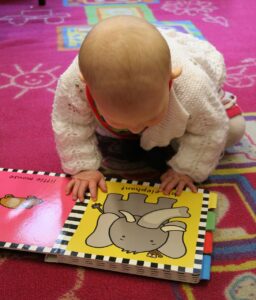
Oct 28, 2024 Little Bookworm Chronicles: Developing Print Awareness
Developing Print Awareness Skills
When my nephews were little, I was fortunate enough to live down the street and visit several times a week! Reading books was the activity we spent the most time doing! It was one of their favorite things to do with me. The memories of me in the middle, laying on our stomachs in a play tent, reading book after book will always be my absolute favorite. I was a children’s librarian then, so of course I felt it was important for me to help develop their early literacy skills during our time reading together.
We know it is important to read with young children, but did you know there are other things you can do while reading a book to help develop their early literacy skills? Working as a children’s librarian, I learned the importance of print awareness and how to work it in to reading with little ones. Once I learned the developmental milestones of print awareness for an infant, toddler, and preschooler, I found it easy to integrate them naturally into my time reading with my nephews and now in my regular storytimes!
Early Childhood Print Awareness Milestones
 INFANTS open/close books and look for or point at printed pictures on the page.
INFANTS open/close books and look for or point at printed pictures on the page.
What You Can Do:
- Provide books that their little hands can handle. (board books, cloth books)
- Provide books with large pictures to make it easier for them to point to.
- Provide books with familiar pictures or objects that draw their interest. (pictures of others babies, ball, toy, dog)
TODDLERS turn book pages and recognize if a printed picture is upside down. Identify the front/back and top/bottom of a book and know where to begin reading on each page.
What You Can Do:
- Model how to hold a book correctly.
- Let them have a turn holding the book and turning the pages.
- Talk about the front and back of the book before reading.
- Point to a few words at a time as you read them to help them understand what a word is.
PRESCHOOLERS begin to identify letters, words, spaces, and some punctuation. When handling or examining print, they will follow the direction of the text.
What You Can Do:
- Point to words when reading to show that print carries a message. For example, “Here are the boy’s words. He says, “please.”
- Use your finger to point to words while reading to have your child follow your finger to see the direction of the text.
- Look for familiar letters like the ones in your child’s name or a family member’s name while reading.
- Count the number of letters in a word and words in a sentence to help them understand to help them understand what a letter is, and that words are made up of letters.
- Point to the title and author of the book as you read.
- Play a game to see how many punctuation marks they can find on a page.
I hope you can incorporate one or two of these print awareness tips when you are reading with your little bookworm!


